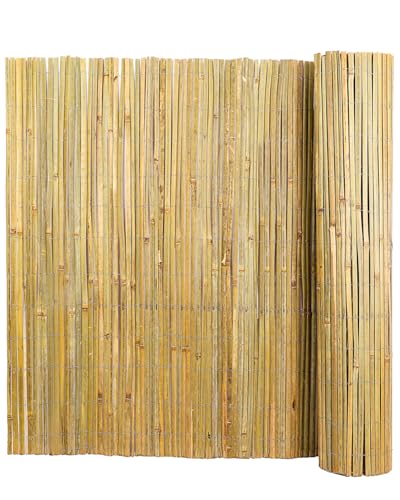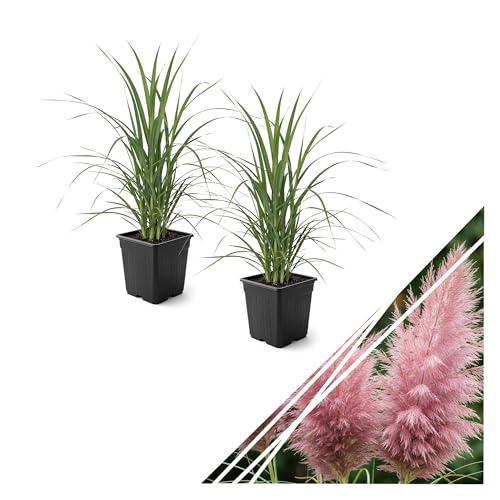Inside: We’ve rounded up 23 Side of House Landscaping Ideas to help you finally do something with that awkward narrow space between your house and fence.
Let’s be honest—most of us completely ignore the side of our house. It’s where the trash cans live, or maybe just weeds and that random pile of stuff you keep meaning to deal with.
But what if that strip of land could actually be useful? Or even beautiful?
Whether you’re tired of looking at a boring walkway, need more privacy from your neighbors, or just want to boost your home’s curb appeal, there are tons of ways to transform this space.
Some are simple weekend projects, others are more ambitious—but they all beat letting it sit there doing nothing.
Ready to see what’s possible? Let’s dive in!
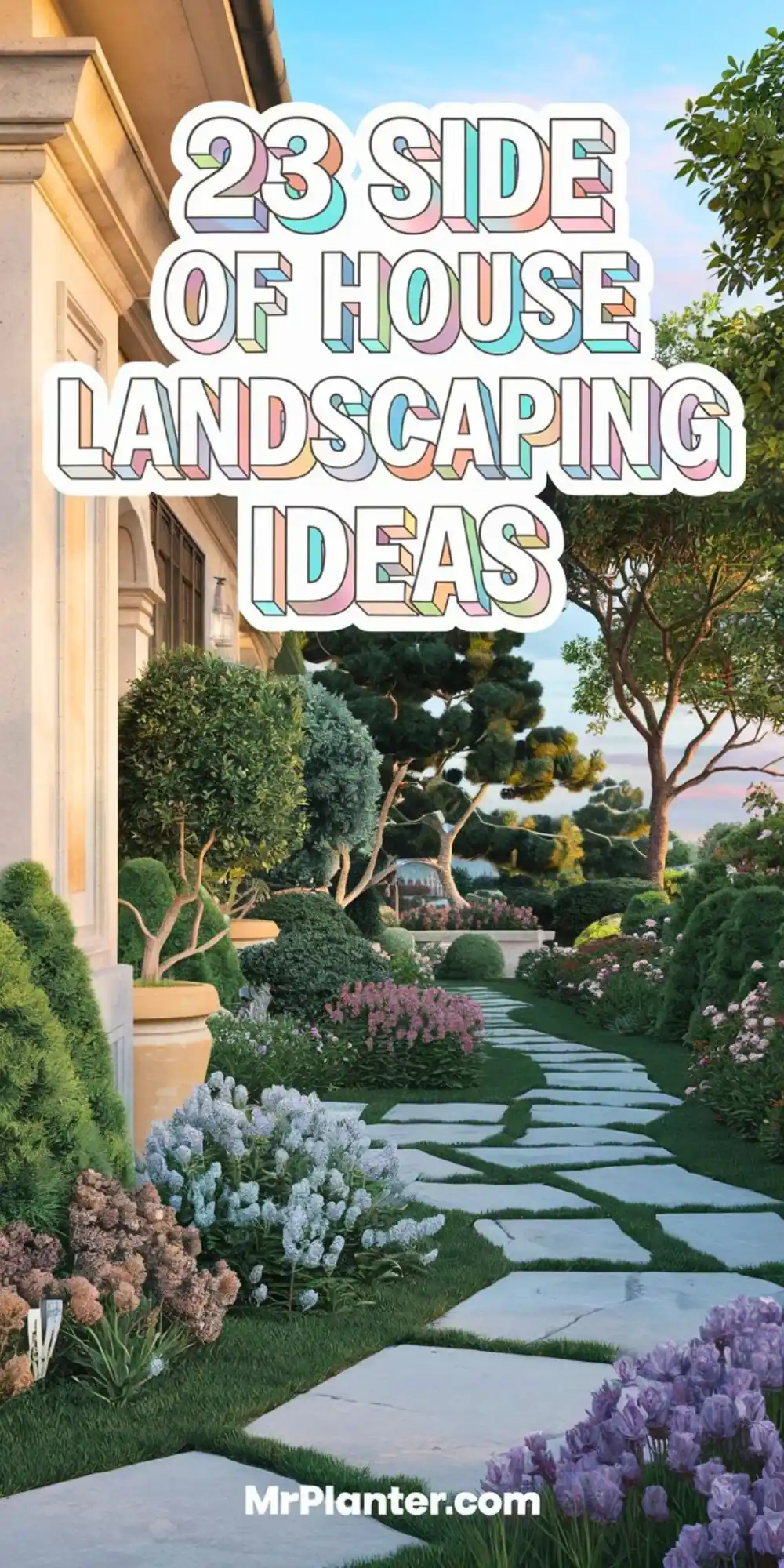
1. Flower Bed Chain
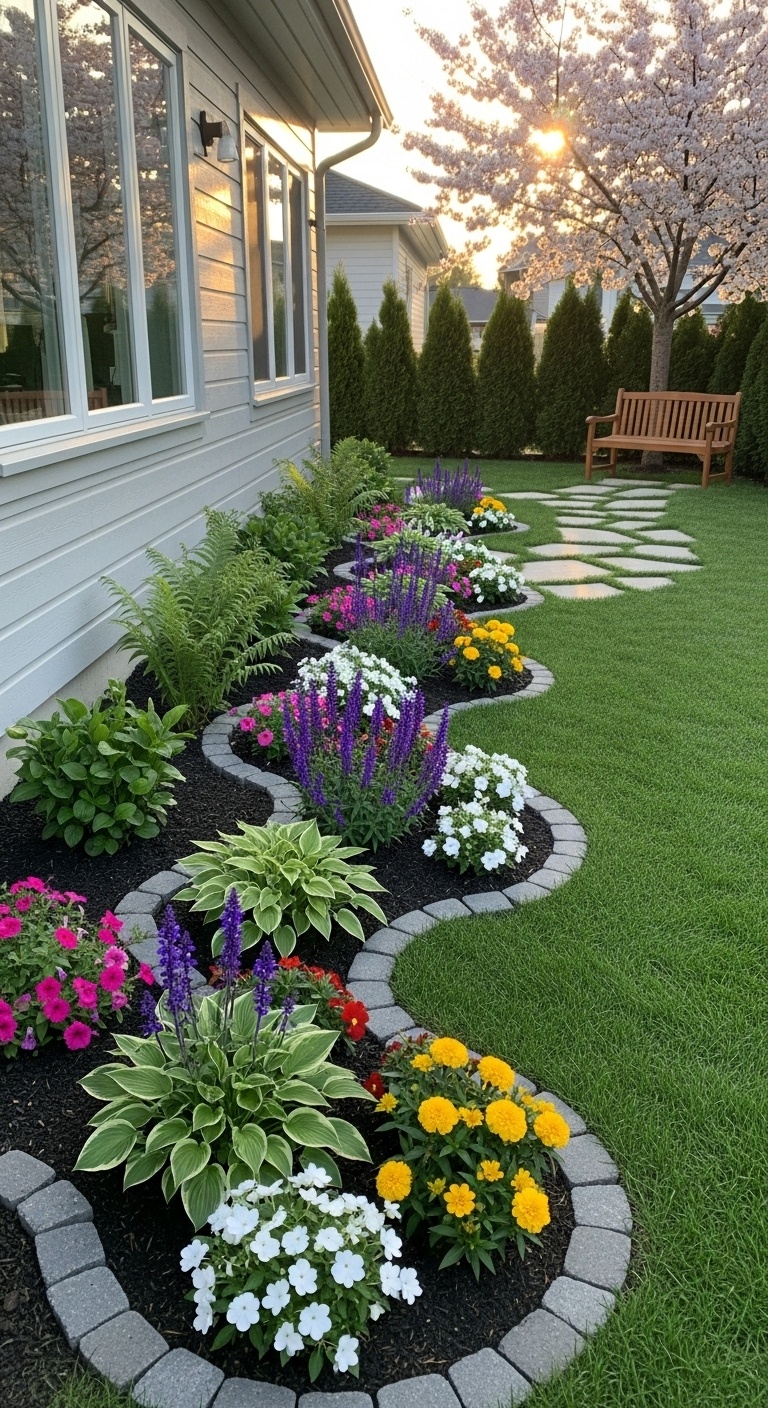
Creating a flower bed chain along the side of your house can enhance its beauty and curb appeal. This design involves planting a series of connected flower beds that flow seamlessly together.
Start by choosing colors and plants that complement each other. Mixing annuals and perennials will provide blooms throughout the seasons.
You can use smaller flowers in the front and taller ones in the back for a layered effect.
Consider using borders or edging to define each bed. This not only keeps the flowers contained but also gives a tidy look.
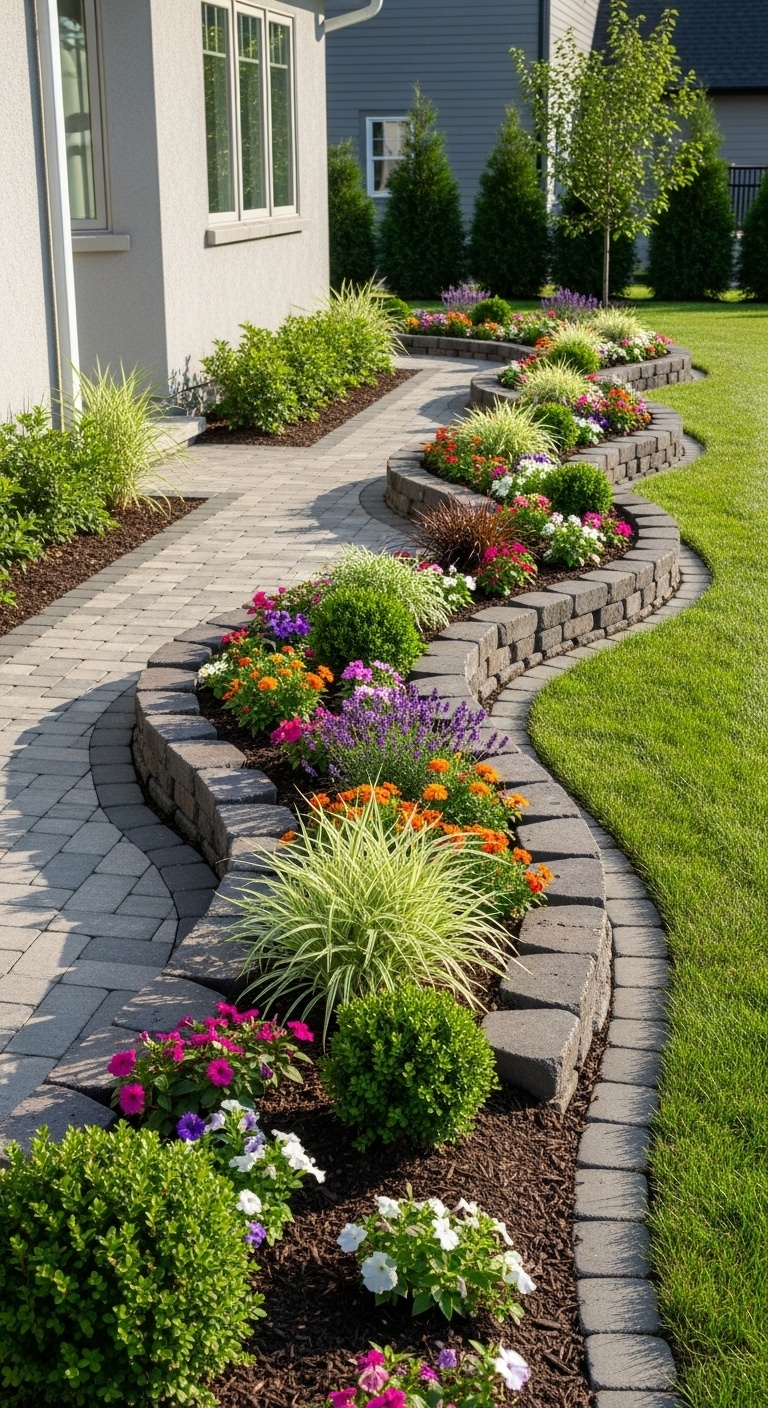
You could use stones, wood, or even plants like hostas to create a natural barrier.
A cascading effect works great along a fence or wall. Hang flower boxes or attach vertical planters. This maximizes space and adds height to your floral display.
Expert Tip from MrPlanter: “This chain can create a lovely visual that draws the eye. Be sure to choose plants that thrive together for the best results.”
2. Gravel Pathway
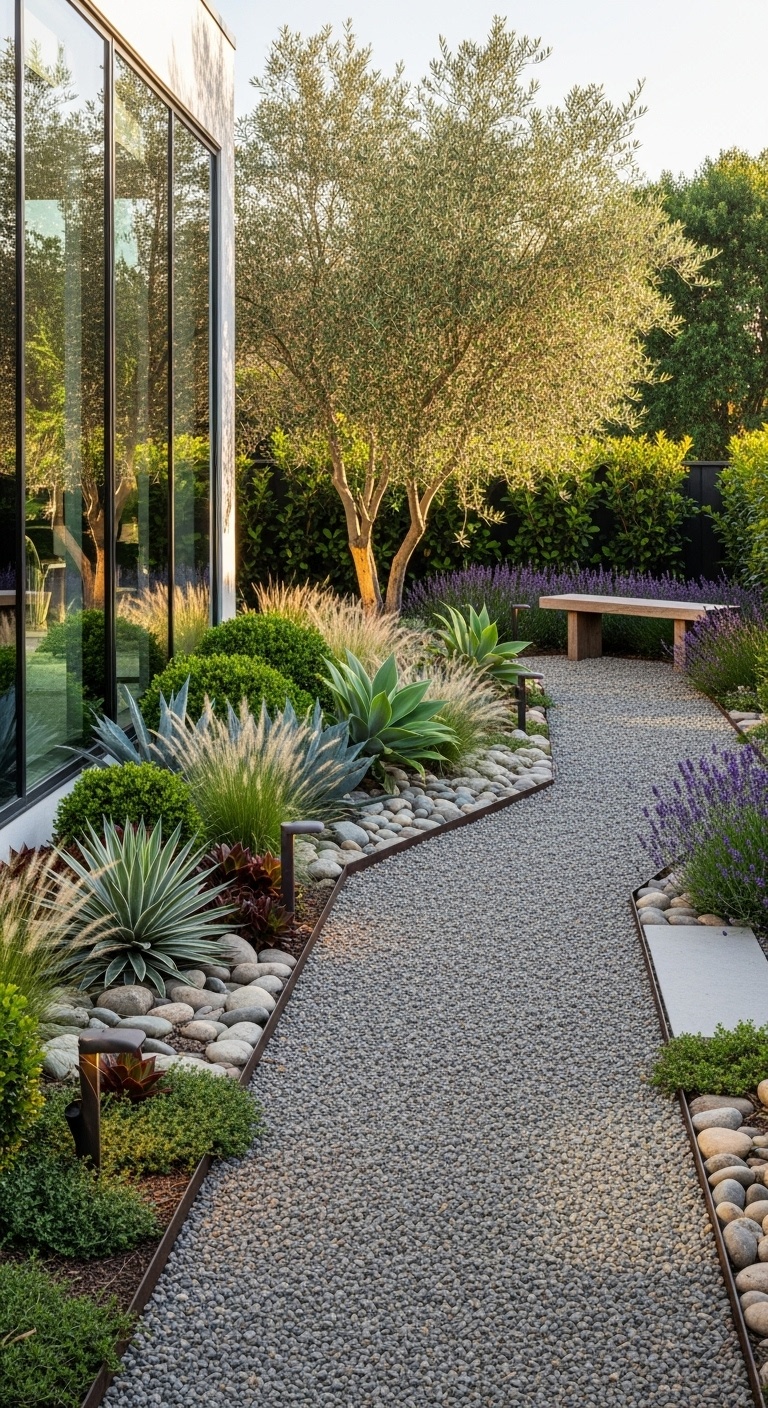
Creating a gravel pathway beside your house can enhance the look of your yard. It’s a simple and budget-friendly project that uses materials like pea gravel or crushed stone.
You can design the pathway in any shape you like, whether it’s straight or winding. This flexibility allows it to fit your yard’s layout and your personal style.
Gravel pathways are not only attractive but also practical. They can help with drainage and reduce mud during rainy days.
You can line the path with plants or bricks to keep the gravel in place. This adds an extra touch of charm and color to your outdoor space.
Expert Tip from MrPlanter: “To keep the path looking neat, use landscape fabric underneath. This will help control weeds and keep the gravel in check”.
3. Raised Planter Beds
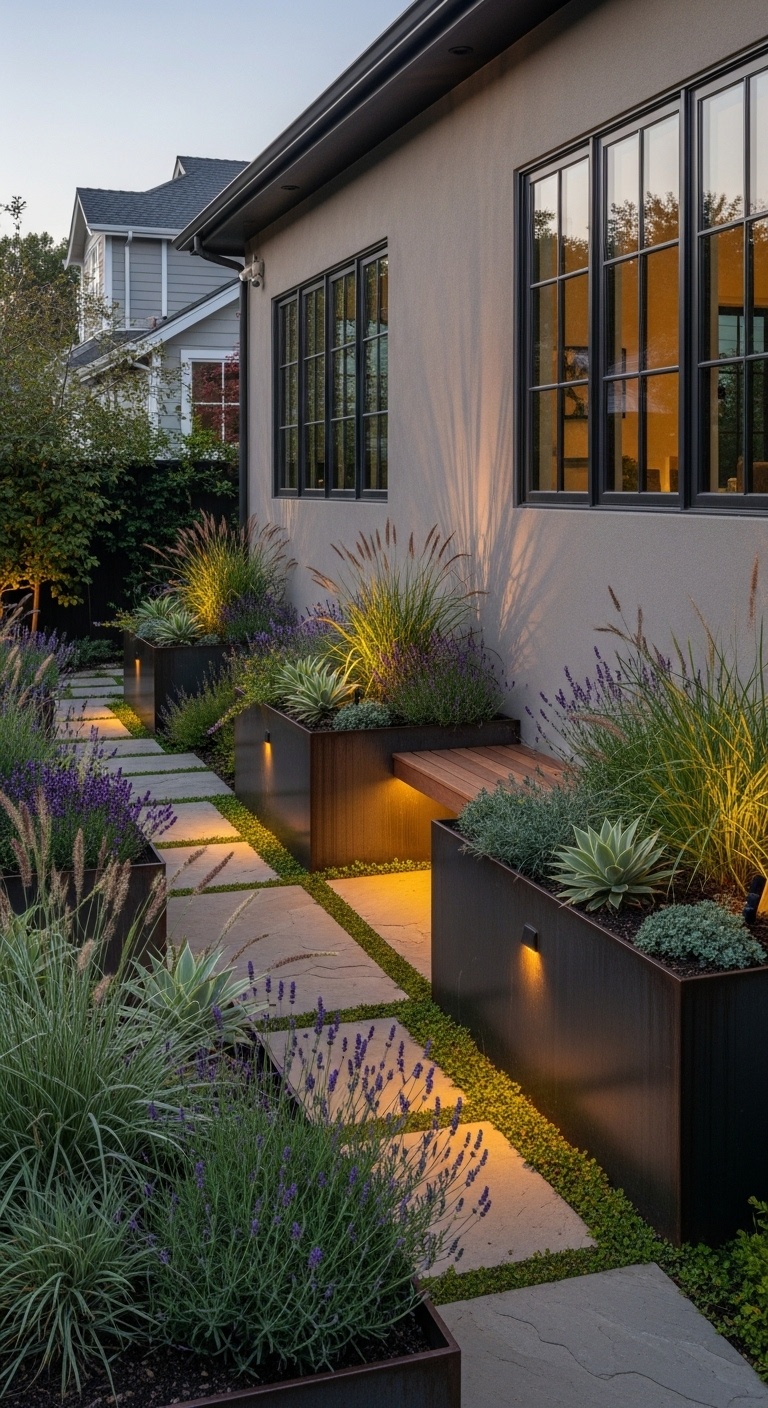
Raised planter beds are a great option for the side of your house.
- DIMENSIONS: 32. 3 in. L x 14. 7 in. W x 30. 7 in. H
- The easiest outdoor herb garden planter with built in water gauge it indicates when plants need additional moisture
- 2FT GROWING DEPTH: 24 inches of depth holds up to 269 gallons of soil-great for medium to deep rooting plants and...
- TOOL-FREE ASSEMBLY: Beveled steel panels come together with a set of included wingnuts and bolts with rubber edging for...
You can build these beds with untreated wood or even repurpose materials you have lying around. They don’t take up much space and can fit into tight areas nicely.
Adding soil rich in compost will boost your plant growth. Plus, raised beds help with drainage and make gardening easier on your back.
Consider different styles, like two-tier beds that let you plant at varying heights. They add dimension and can be really eye-catching.
Expert Tip from MrPlanter: “Keep your raised beds simple for easy maintenance. Choose plants that thrive in your specific sunlight and soil conditions.”
4. Perennial Garden
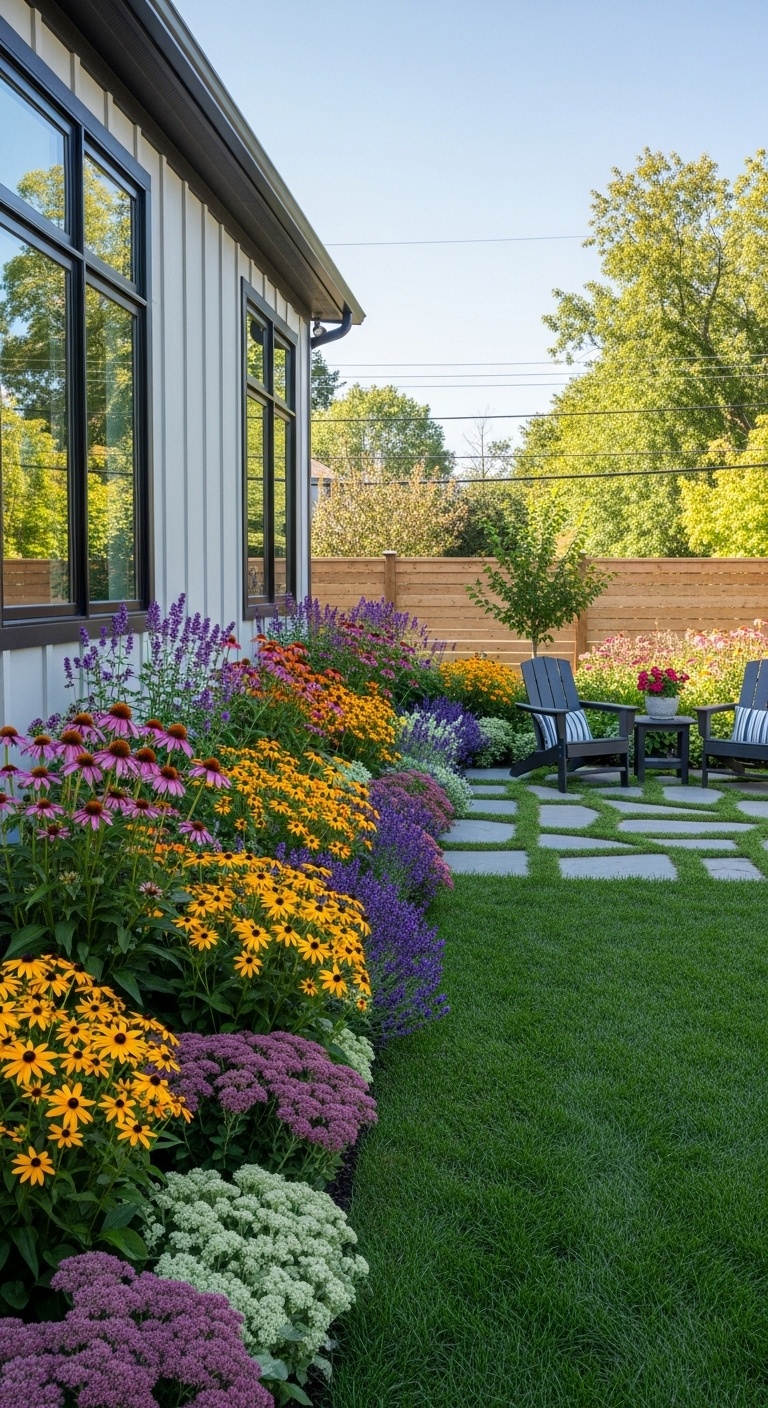
Creating a perennial garden beside your house can add color and life. Perennials bloom year after year, making them a smart choice for lasting beauty.
You might consider flowers like chrysanthemums and sedums for autumn blooms. These plants show off vibrant colors as the seasons change.
You can mix and match plants for textures and shades. Japanese maples and heuchera are great for foliage.
Planting in layers helps to create depth. Taller plants can go at the back, while shorter ones stay in front.
Expert Tip from MrPlanter: “Choose plants that thrive in your local climate for the best results. Always check the sunlight requirements before planting.”
5. Bamboo Screening

Bamboo is a great choice for adding privacy to your side yard.
- Premium Materials- Our bamboo fence is made from high-quality bamboo, handcrafted and sourced from the subtropical...
- Upgraded Craftsmanship- Compared to ordinary bamboo, we use high-quality moso bamboo, which has a smooth, glossy...
- Premium Materials- Our bamboo fence is made from high-quality bamboo, handcrafted and sourced from the subtropical...
- Upgraded Craftsmanship- Compared to ordinary bamboo, we use high-quality moso bamboo, which has a smooth, glossy...
You can choose running or clumping bamboo. Clumping bamboo is easier to manage because it doesn’t spread wildly like running bamboo.
It can reach heights of about 15 feet in just a few years, offering solid coverage.
Plant bamboo in a sunny spot with well-drained soil to help it thrive. Regular watering is key, especially when it’s getting established.
Make sure to space the plants according to their type. This will help them grow strong without fighting for resources.
Expert Tip from MrPlanter: “Bamboo is a low-maintenance plant once set up, but watch out for its growth! Control it with regular trimming to keep your garden tidy.”
6. Vertical Gardens
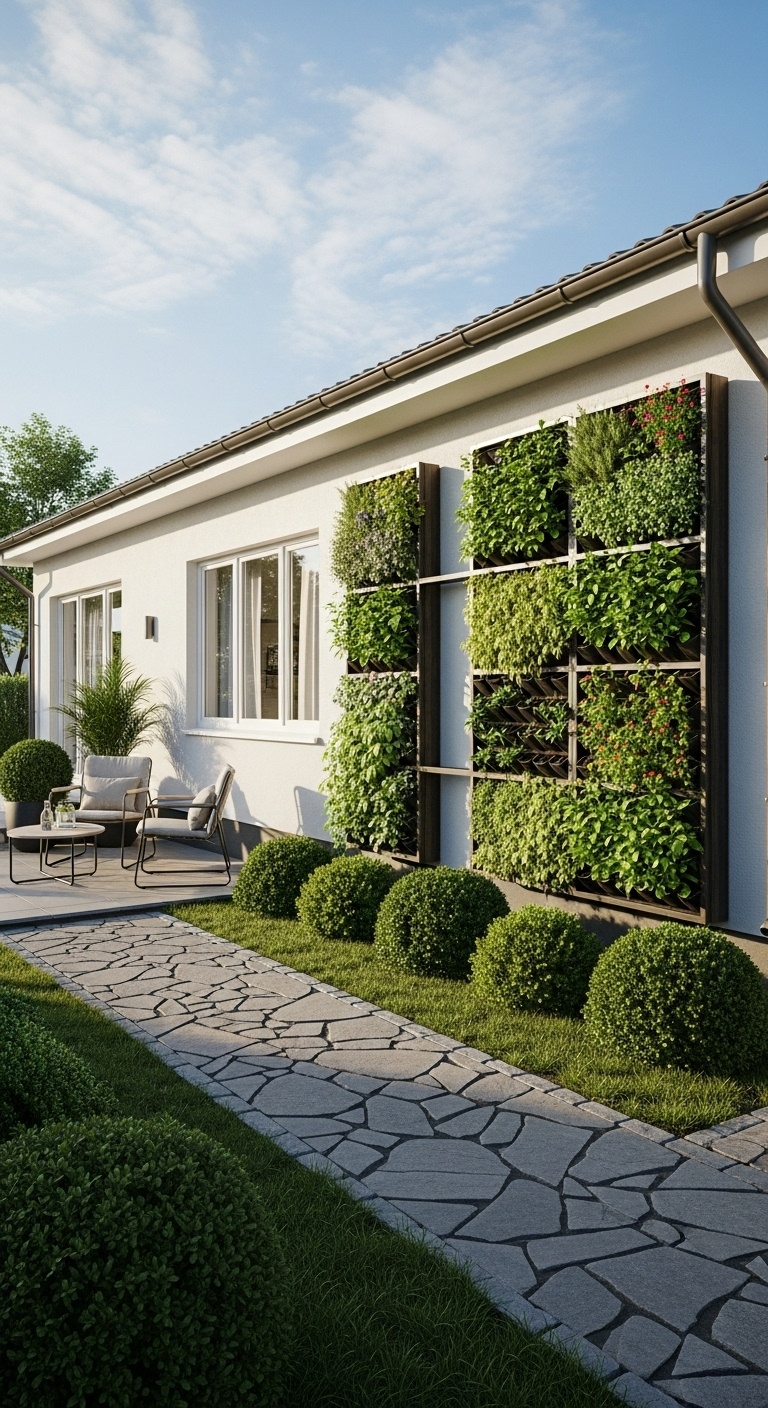
Vertical gardens are a smart way to make the most of your side yard space. They allow you to grow plants upwards instead of outwards, saving ground space.
You can use walls, fences, or trellises to support your garden. Materials like wooden pallets or wire mesh work great for holding your plants.
Consider using various plants, including flowers, herbs, or even vegetables. This creates a beautiful and useful garden.
Place your vertical garden where it gets enough sunlight and is easy for you to reach. Regular watering and maintenance will keep your plants healthy.
Expert Tip from MrPlanter: “Choose plants that thrive in your climate, and don’t be afraid to mix different types. A little creativity can turn your side yard into a green oasis!”
7. Water Feature
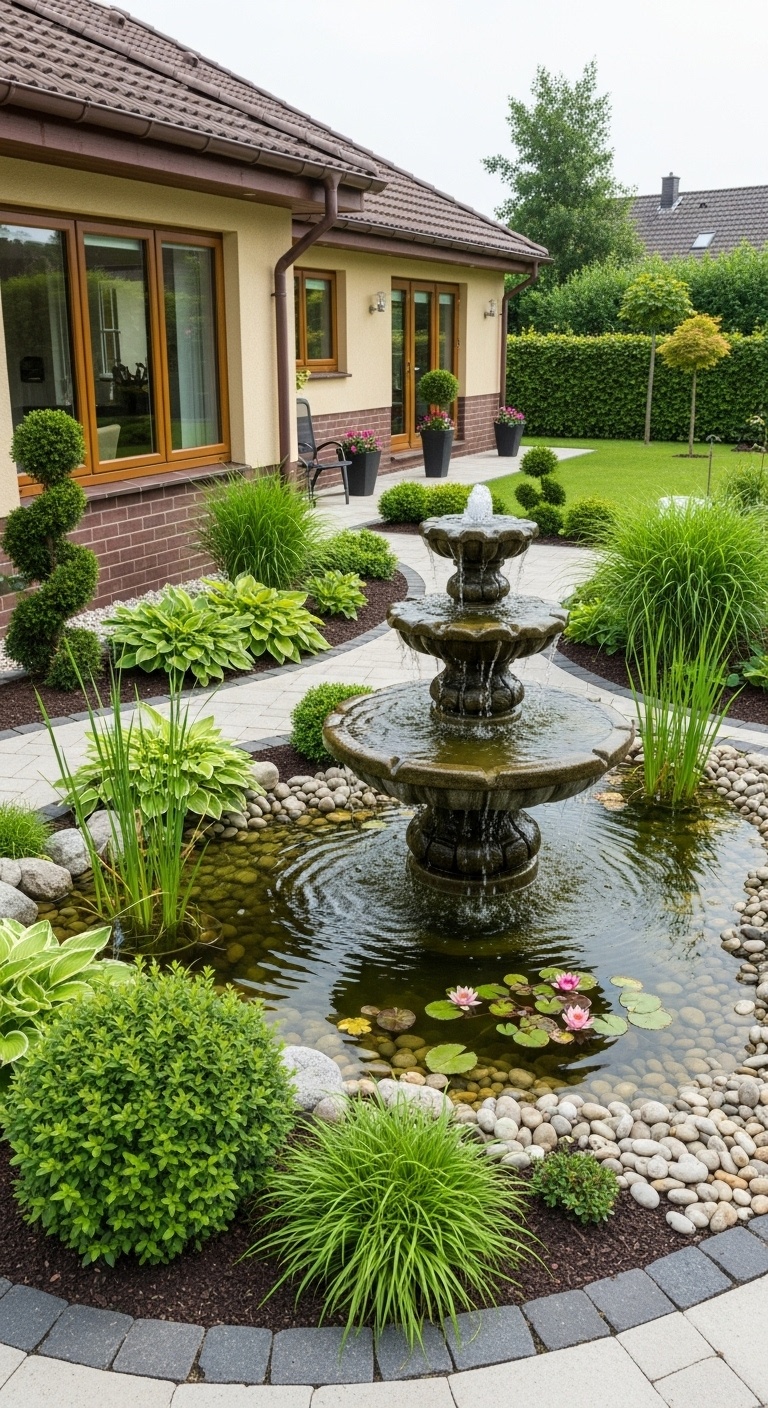
Adding a water feature to the side of your house can create a peaceful vibe. Whether it’s a small fountain or a compact pond, water has a calming effect.
You can choose a design that fits your space. If you have a small area, a wall fountain takes up little room.
- DURABLE, LIGHTWEIGHT RESIN: This wall water fountain won't damage walls, fencing, etc.; great option indoors too
- LED FEATURE: Fountain illuminates from the bottom for a unique decorative option
- ATTRACTIVE ANTIQUE ADDITION TO ANY SPACE: Make a statement with this stunning outdoor wall fountain for the garden,...
- DURABLE MATERIAL THAT'S BUILT TO LAST: The wall-mounted water fountain is made from polystone material to ensure it will...
Consider plants around your water feature. They can enhance the natural look and provide shade for fish if you choose a pond.
It’s also a great way to attract birds and butterflies. They will love the water source in your yard.
Expert Tip from MrPlanter: “Place your water feature where you can see it often. This helps you enjoy the relaxation it brings to your space.”
8. Stone Steps
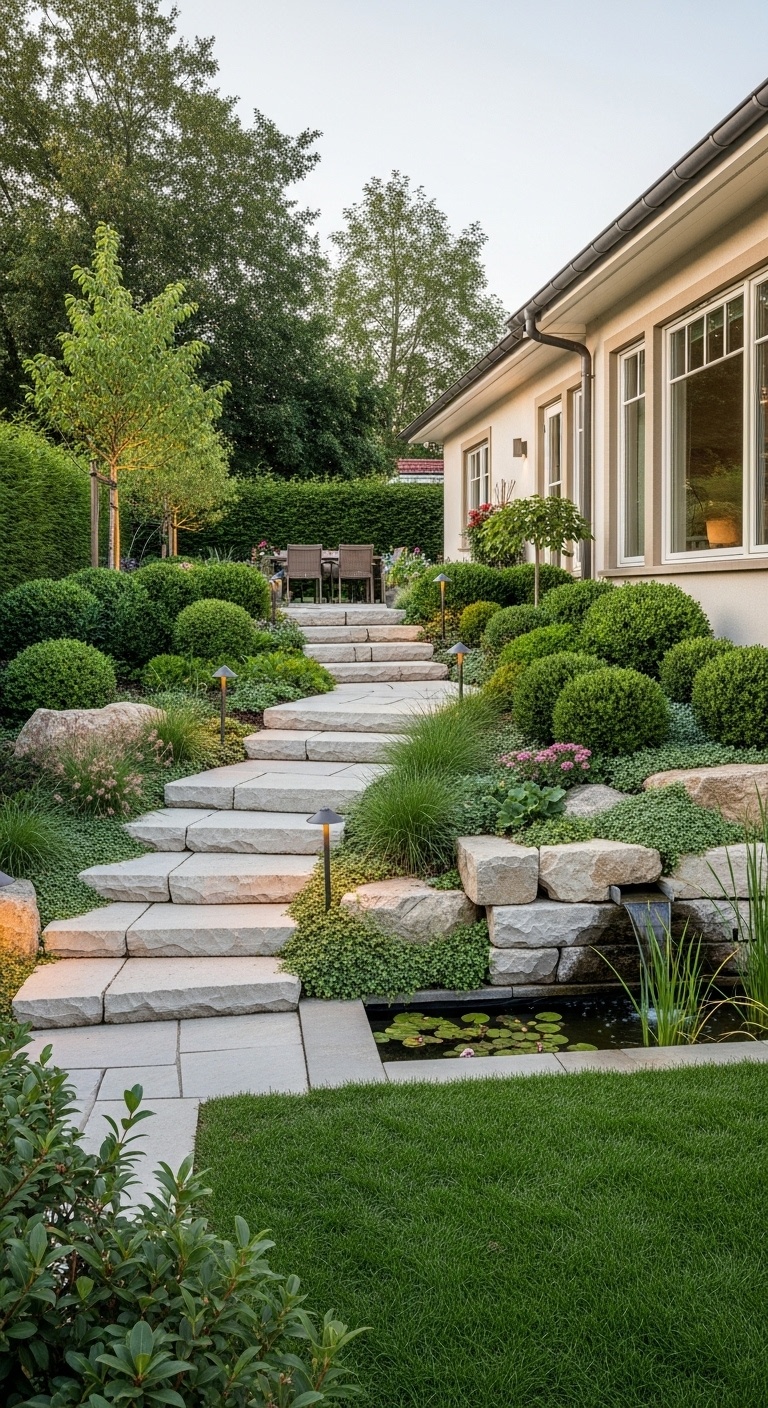
Stone steps can add charm and function to the side of your house. They make it easier to navigate sloped areas or gardens.
You can choose different types of stones for various looks. Flagstones give a more rustic feel, while smoother stones provide a neater appearance.
When planning your stone steps, think about spacing. Make sure they’re evenly placed to create a safe path.
Adding plants around your stone steps can enhance the area. Consider using low-maintenance flowers or ground covers for added color.
Expert Tip from MrPlanter: “Always level your stones to prevent accidents. A little planning goes a long way in creating a beautiful and safe walkway.”
9. Topiary Borders
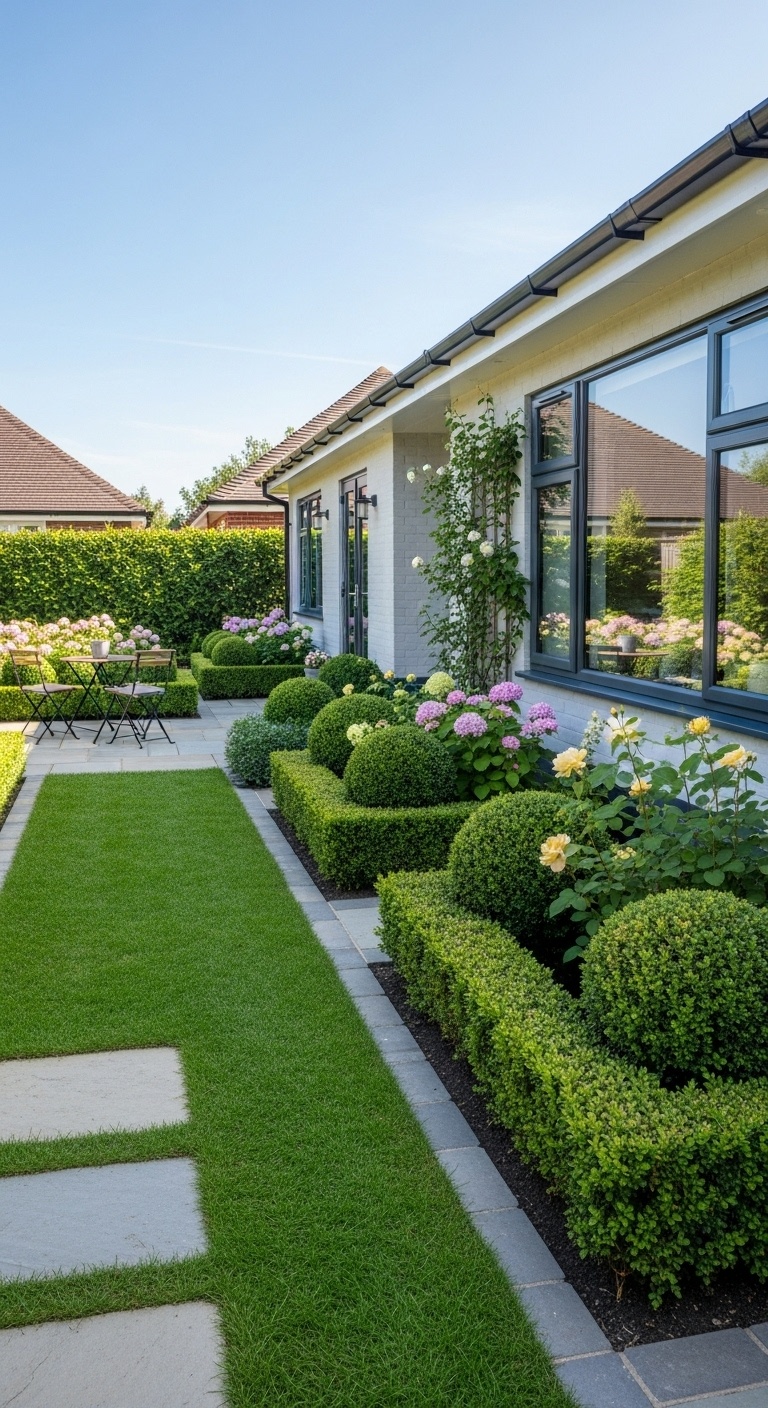
Topiary borders can really enhance the space beside your house. These shaped plants add style and create a neat look. You can choose from various shapes like balls, spirals, or cones.
Using topiaries as borders defines the area and offers a contrast to other plants. Their evergreen nature means they stay attractive year-round. This can bring a sense of structure to your garden.
Plant topiaries closer to pathways to make your garden feel inviting. They work well in formal designs but can also fit into more casual spaces.
Remember to keep up with trimming to maintain those shapes. Regular care keeps them looking their best and adds to your home’s charm.
Expert Tip from MrPlanter: “Topiaries are not just decorative; they serve as natural dividers too. Use them wisely to create distinct areas in your garden.”
10. Outdoor Sculptures
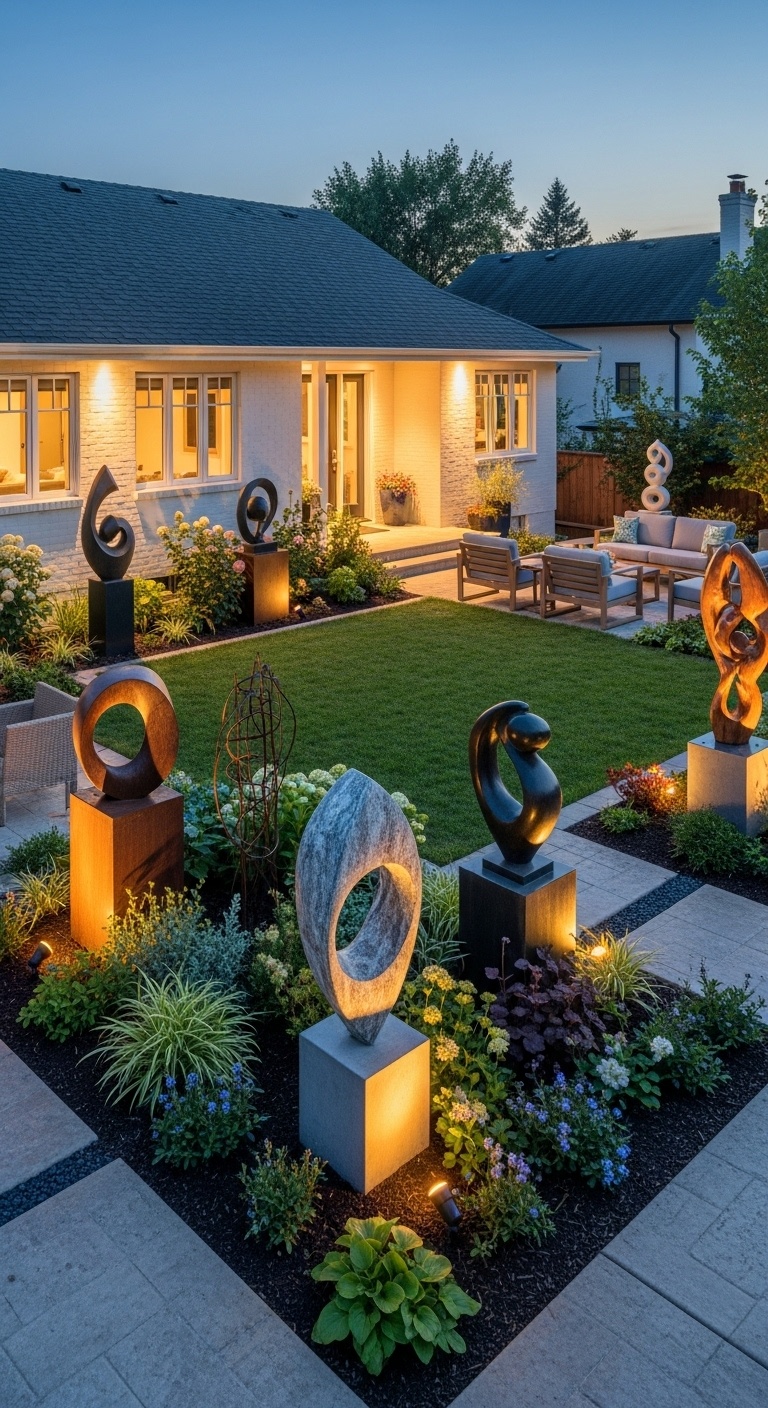
Adding outdoor sculptures to your side yard can bring personality and style.
- 【Christmas Gifts】This yard gnome garden decor figurines is one of the best gifts.Our garden statue and solar light...
- 【Solar Christmas Garden Gnomes】 Please turn on the button at the side of the lantern before use.Then keep the...
- Stack of 8 river rocks, balanced one atop the other for a unique look
- Carins have been used since prehistoric times to mark important sites or paths
You can choose from various materials like stone, metal, or wood. These sculptures can serve as focal points or add interest to your garden.
Mixing different sizes and shapes creates visual appeal. Don’t hesitate to place them among your plants or near your entrance for extra charm.
Think about how the sculptures will look at different times of the day. Many pieces shine in sunlight or take on a lovely glow at dusk.
Expert Tip from MrPlanter: “Choose sculptures that reflect your personality. They can turn any side yard into a personal art gallery.”
11. Hanging Baskets
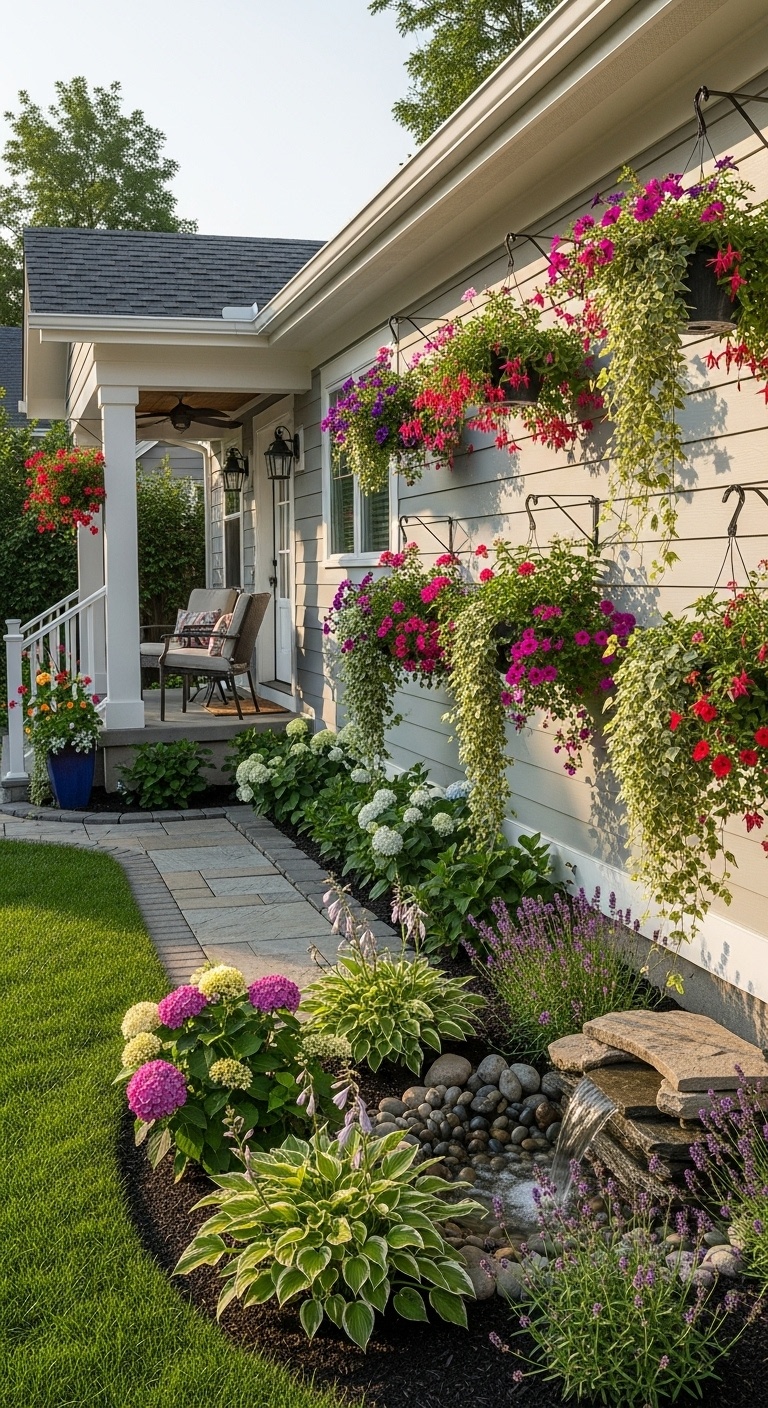
Hanging baskets are a great way to add color and texture to the side of your house. You can choose from a variety of plants, including trailing vines and vibrant flowers. These baskets bring life to spaces that might otherwise feel empty.
Consider using plants like calibrachoa, petunias, or sweet potato vine for dramatic effect. Mixing different colors helps create an eye-catching display. Adding interesting foliage can make your hanging basket stand out, too.
Make sure your hanging baskets receive enough sunlight. Most flowering plants thrive in bright conditions. Water them regularly to keep them healthy and growing.
You can easily change your hanging baskets with the seasons. Swap out plants to keep your home looking fresh year-round.
12. Ornamental Grasses

Ornamental grasses can add beauty and texture to the side of your house.
- ORNAMENTAL & DECORATIVE: Adds texture, movement, and elegance to any garden, patio, or landscape design.
- EASY TO GROW: Thrives in full sun and well-drained soil, with minimal maintenance required.
- Pampas grass is ornamental. Fresh green foliage reaches 8 to 12 feet tall, topped by long, thick silky "featherdusters"
- Pampas ornamental grass grows fairly fast making it an ideal choice for filling in large, barren landscapes
Using taller grasses can also help provide privacy without the need for fences. For instance, little bluestem can create a lovely screen while looking natural.
Mixing different types of grasses can enhance your garden by adding layers and depth. They work well with flowers and shrubs, making your landscape look fuller.
When planning your garden, consider the season. Some grasses have features that change throughout the year, offering year-round appeal.
13. Mini Herb Garden
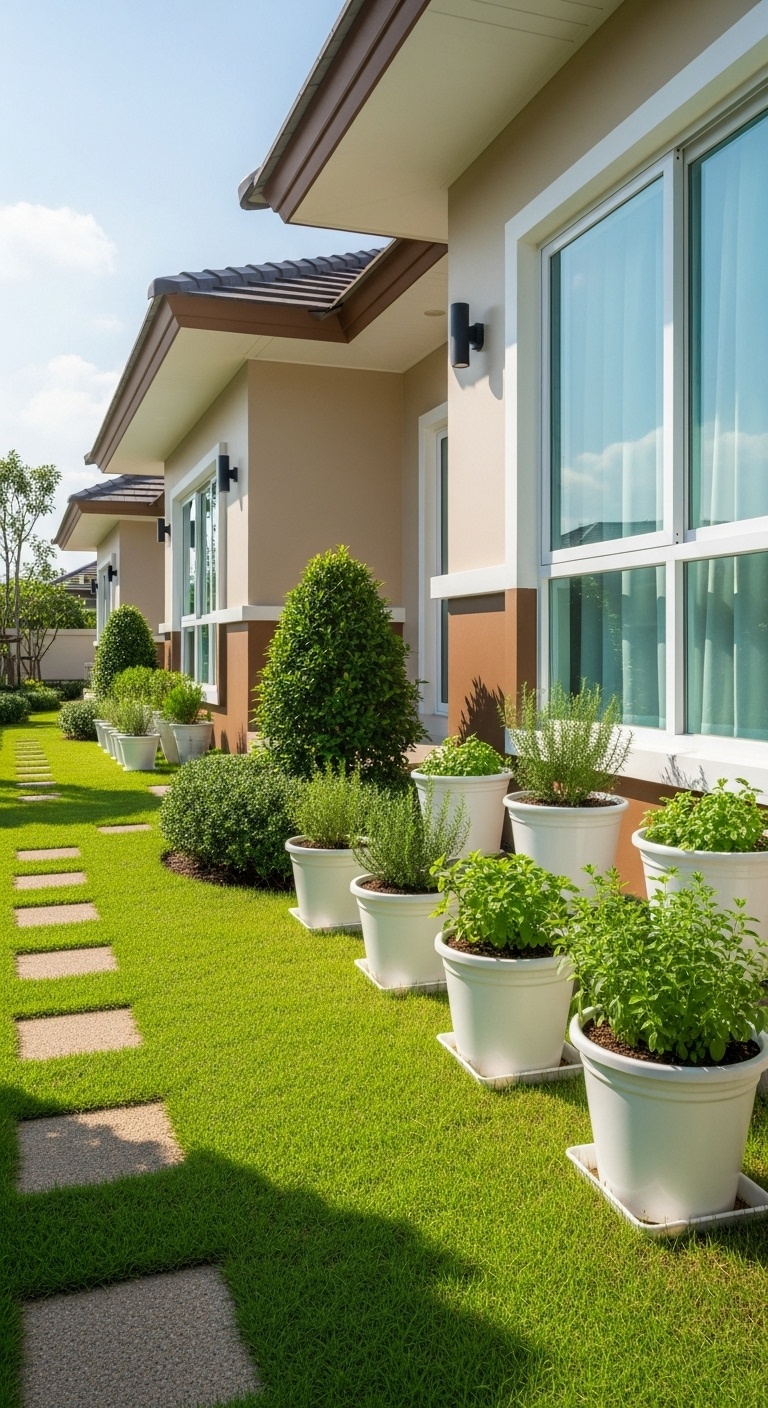
Creating a mini herb garden by your side door or on a small patio can be a fun project. Herbs like basil, parsley, and chives are easy to grow and useful in your kitchen.
You can use small pots or containers to save space. Arrange them by size and color for a nice look. Make sure they get plenty of sunlight and water regularly.
A mini garden not only adds greenery but also saves money on fresh herbs. You can pick what you need when cooking.
14. Rock Garden
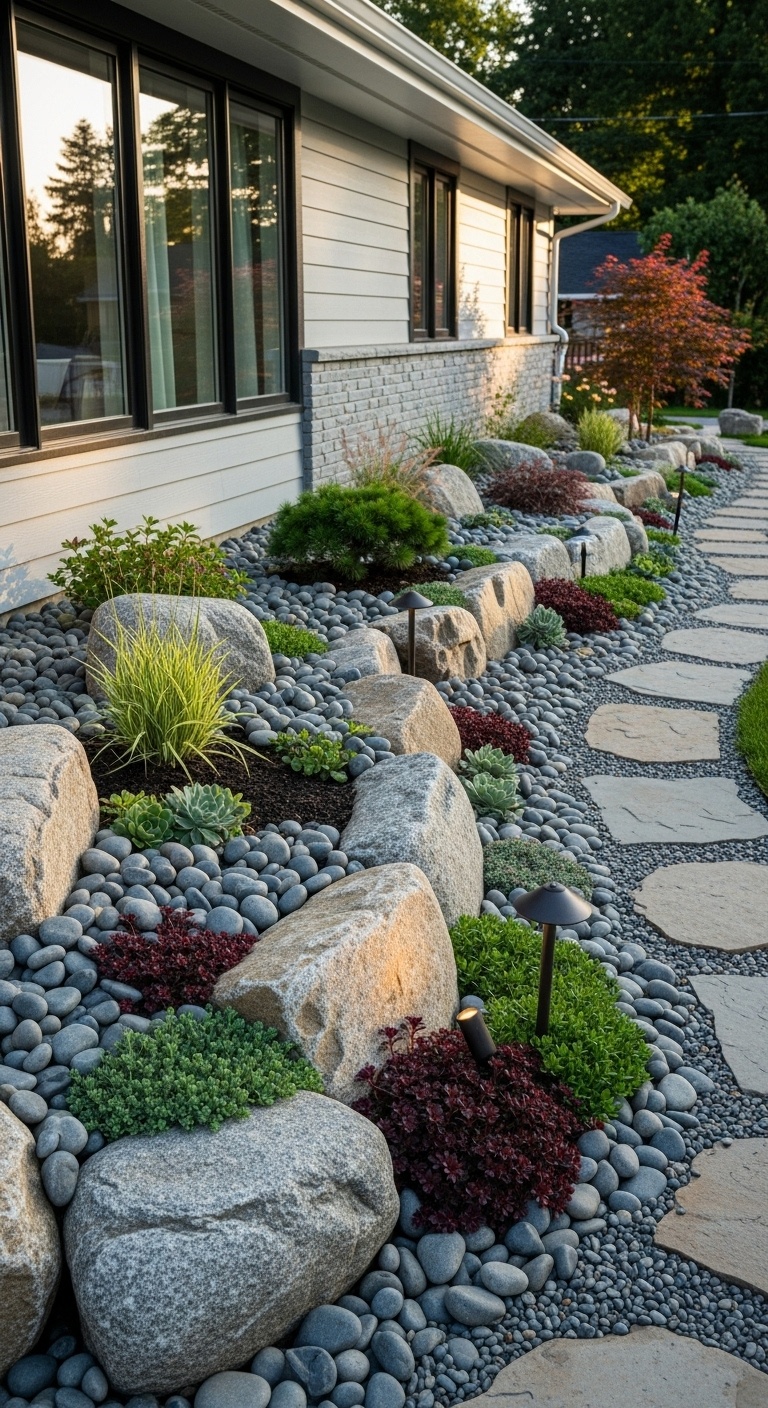
Creating a rock garden by the side of your house can add charm and style. Start with a mix of rocks in different sizes and shapes. This helps create depth and interest.
Use drought-resistant plants like succulents and ornamental grasses. They thrive in rocky settings and need less water. Groundcovers can soften the hard edges of the rocks.
Consider adding colorful flowers and hardy bulbs, like wild tulips or daffodils, for more color. The mix of plants and rocks will make your garden pop.
You can also layout the rocks in a way that mimics natural hillsides. This technique can enhance the feel of your garden.
15. Creeping Groundcover

Creeping groundcovers are a great way to enhance the side of your house. They spread easily and help fill in bare spots. Plus, they can handle tough conditions like shade and poor soil.
Plants like creeping thyme, creeping phlox, and sedum work well. They add color and texture without needing much maintenance. This means less weeding and watering for you!
Creeping groundcovers also prevent soil erosion. This is perfect for sloped areas next to your home. Over time, they create a lush, green carpet that looks nice year-round.
16. Privacy Fence with Vines

A privacy fence adds security and a feeling of seclusion to your yard.
- Perfectly Protect Your Yard Privacy: 90% visibility blocking, prevent peeping outside the yard, block nose neighbors see...
- High Quality Material: Made of brand new breathable polyethylene fabric, the fabric is tight and flat, the fabric has...
- Privacy Solution: Most economical way for privacy over chain link fence, porous decorative concealment, existing cyclone...
- High quality material: privacy fence screen is constructed of sun protected HDPE fabric with brass grommets on each...
Choose vines that grow well in your climate. Some popular options include clematis, ivy, and wisteria. Be sure to check if they can handle the sunlight and conditions in your yard.
You’ll need to install a trellis or a grid on the fence to support the vines. This helps them climb and spread evenly. Regular pruning will keep them neat and help them grow strong.
Vines not only increase privacy but also attract butterflies and birds. That adds life and color to your space.
17. Simple Seating Area
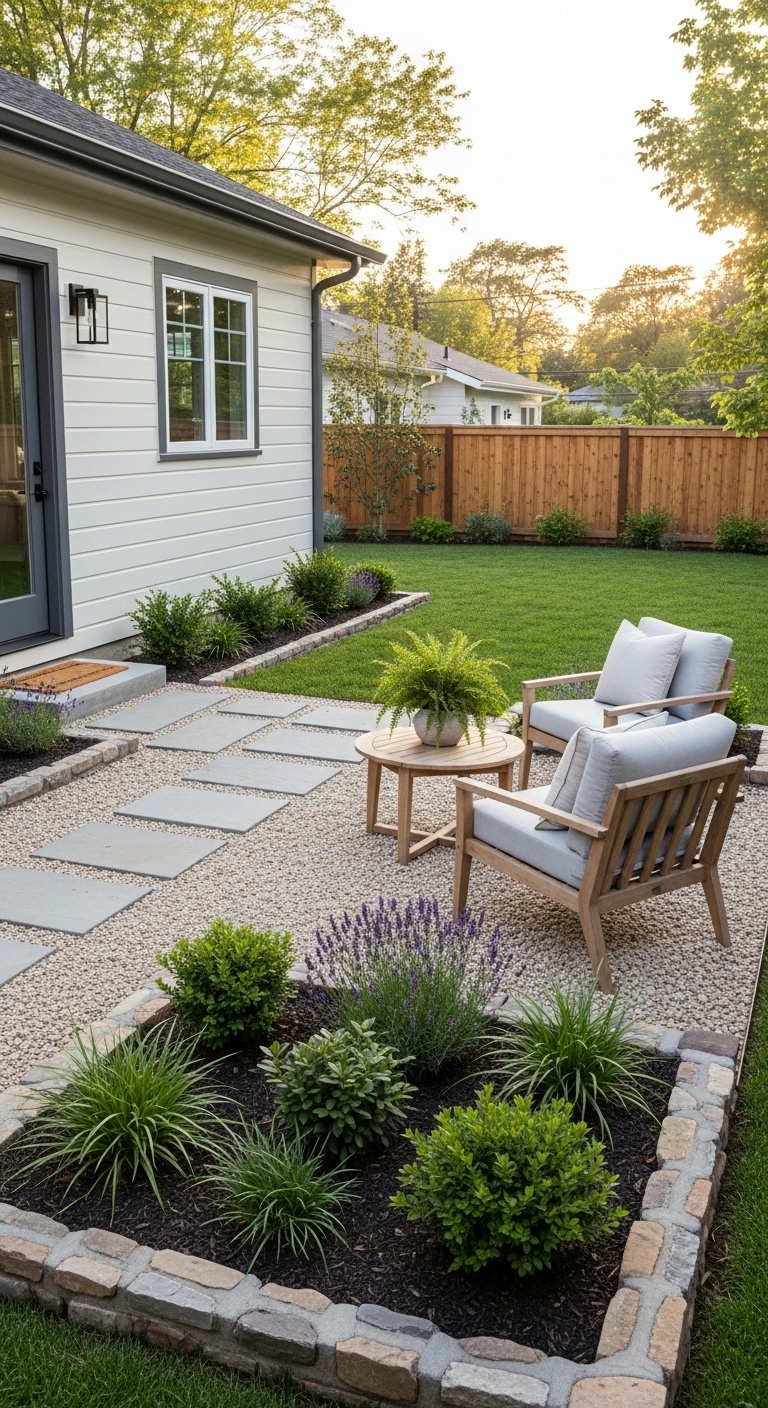
Creating a simple seating area on the side of your house can be a great way to enjoy your outdoor space. You can use a small table and a couple of chairs. This provides a cozy spot for morning coffee or afternoon reads.
Consider foldable furniture to save space when not in use. Options like lightweight chairs and collapsible tables are perfect for smaller areas. You can easily tuck them away and make room when you need it.
Adding some soft cushions can make your seating area feel even more inviting. You might also think about small plants or decorative items to add some charm.
18. Flagstone Walkway
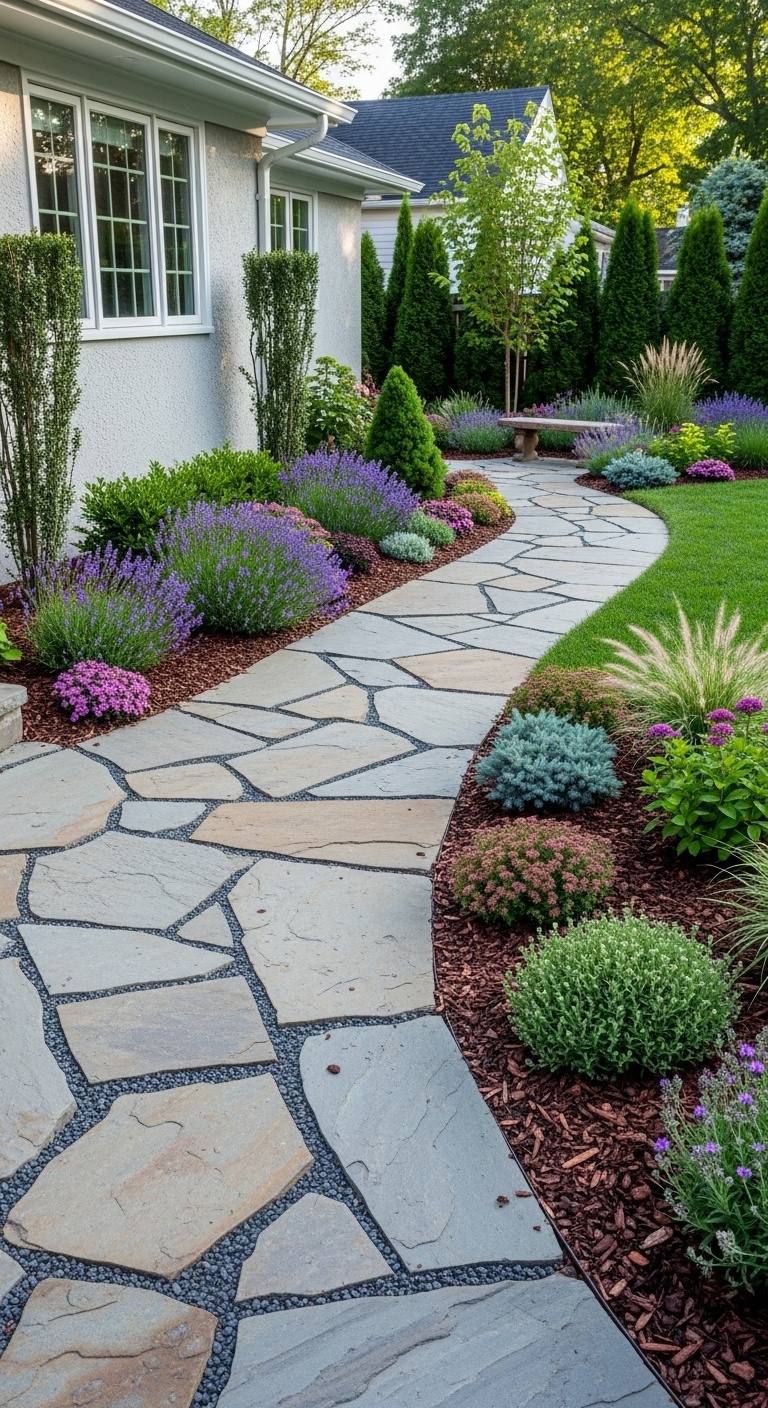
A flagstone walkway can add charm to the side of your house. It fits well with gardens and gives a natural look. You can use irregular stones for a rustic feel or cut stones for a cleaner look.
To create your walkway, first clear the area by removing grass and topsoil. Lay down washed sand to help with drainage. Then, place your stones with at least one inch between them.
You can also add plants along the sides to make the path more inviting. This creates a pleasing view and attracts butterflies and birds.
19. Outdoor Lighting
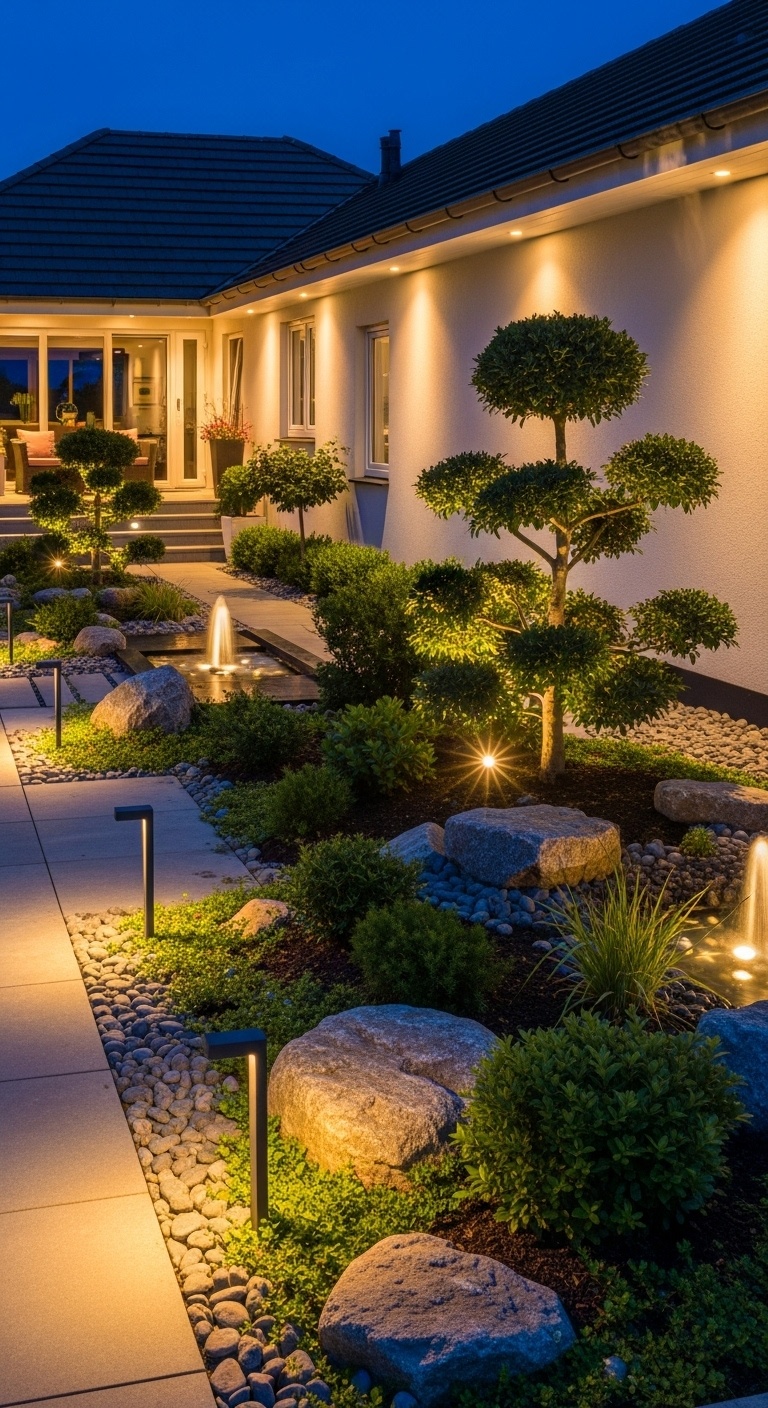
Outdoor lighting can make a big difference in how your side yard looks. It also adds safety by lighting pathways and steps.
Consider using stake lights along your walkways. These are easy to install and provide a nice glow at night. You can also place bullet lights by stairs for extra visibility.
Another option is to mount lights on fences. This gives a downward beam, which is great for lighting up your yard. Make sure to space them evenly for the best effect.
Draping tiny white lights on shrubs creates a warm, inviting feel. It looks lovely, especially with flowers like tea roses at night.
20. Decorative Mulch
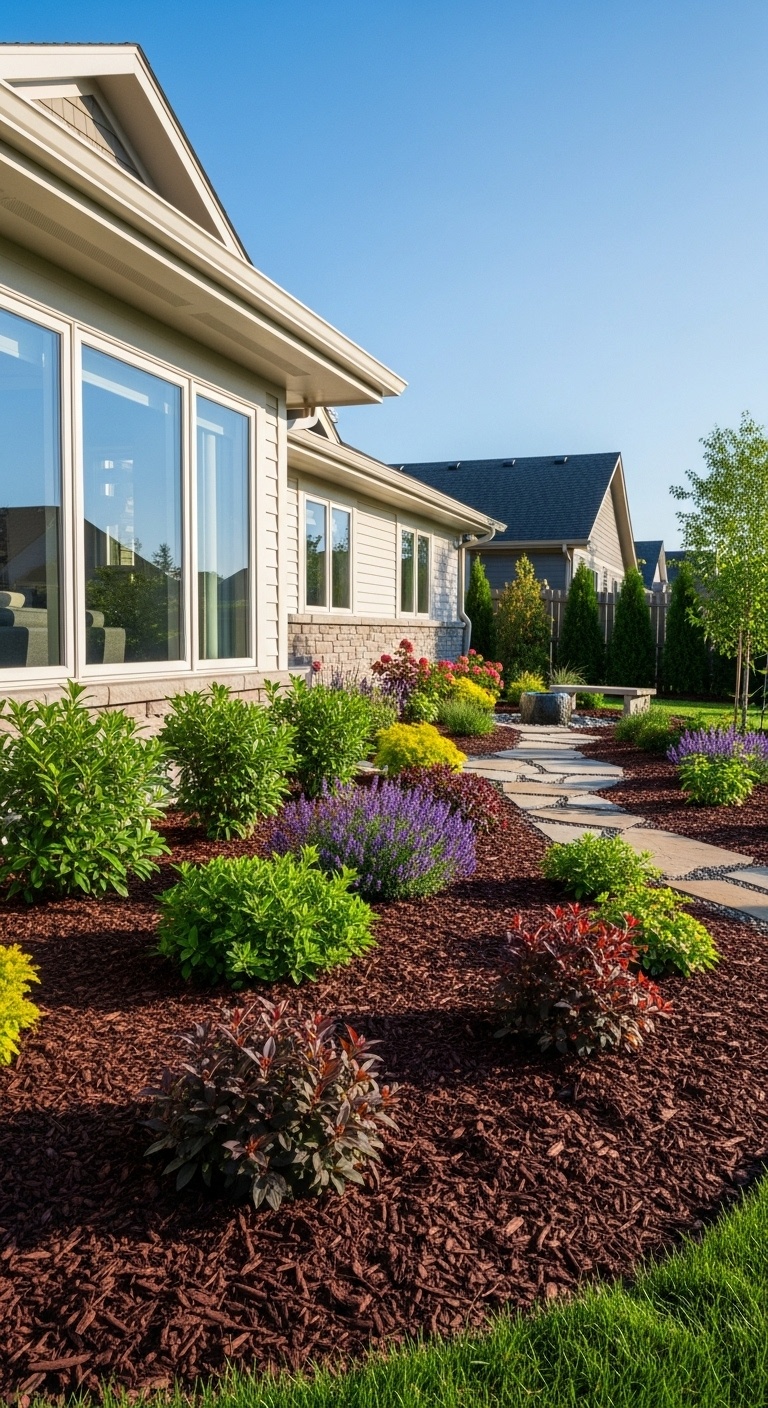
Decorative mulch adds color and texture to the side of your house. It helps to control weeds while giving your garden a clean look. You can choose from various materials like wood chips, stones, or rubber.
Using a mix of mulch types can create interest in your landscape. For instance, combining dark mulch with lighter stones can help highlight your plants.
You can also match the color of mulch with your home’s exterior. This creates a cohesive look and enhances curb appeal.
Expert Tip from MrPlanter: “Don’t forget to refresh your mulch regularly. Over time, it breaks down and can lose its color.”
21. Reclaimed Wood Edging
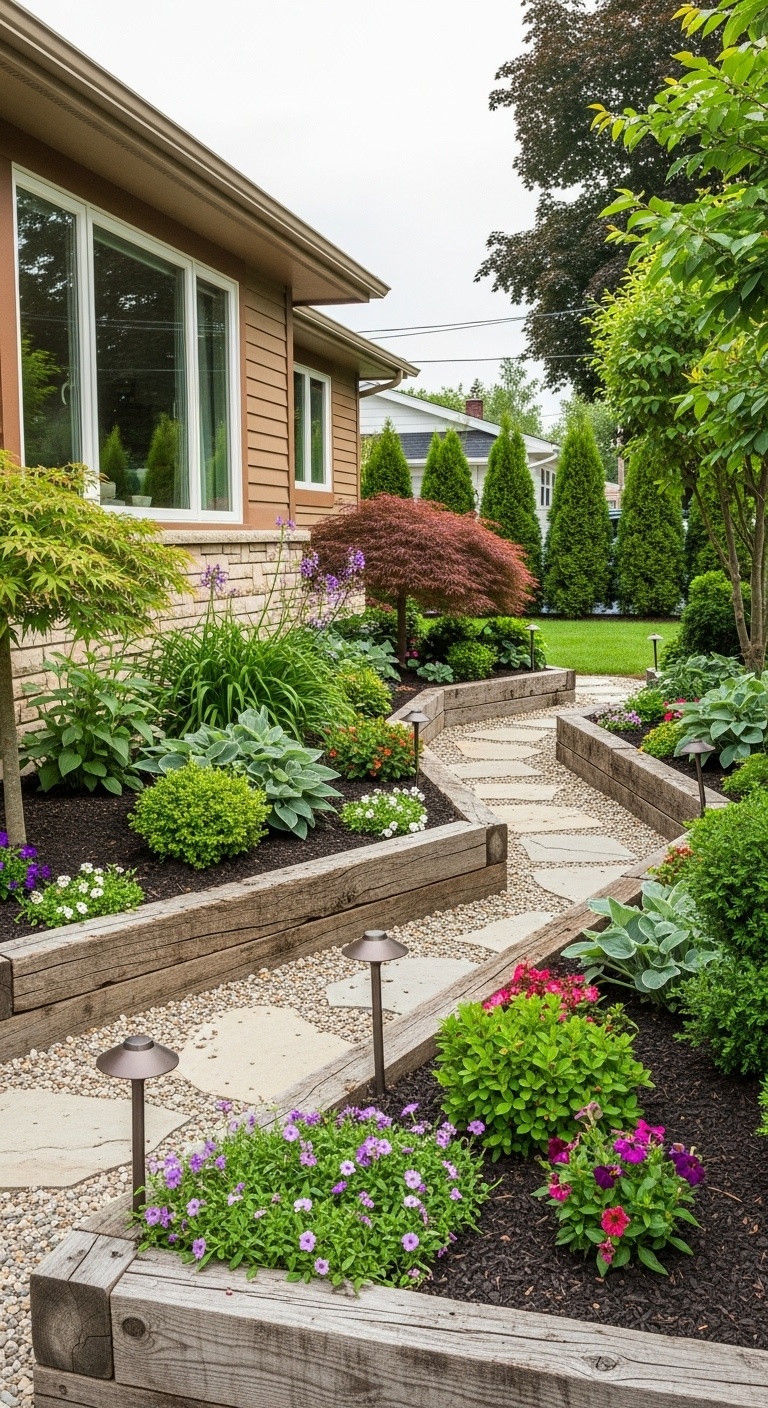
Reclaimed wood edging can add charm to your landscape. It’s eco-friendly and gives your garden a rustic look.
You can use old pallets or fence boards for a unique touch.
Cut the wood to your desired lengths. Arrange them in a trench around your flower beds or pathways.
This will help keep soil and mulch in place.
Using reclaimed wood means you can often find materials at little or no cost. It also reduces waste, making this option budget-friendly and sustainable.
Make sure the wood is free from rot. You might want to treat it with a sealant to increase its durability against weather.
Expert Tip from MrPlanter: “Reclaimed wood can be a conversation starter in your garden. Be creative and mix different types for a unique border.”
22. Modern Succulents
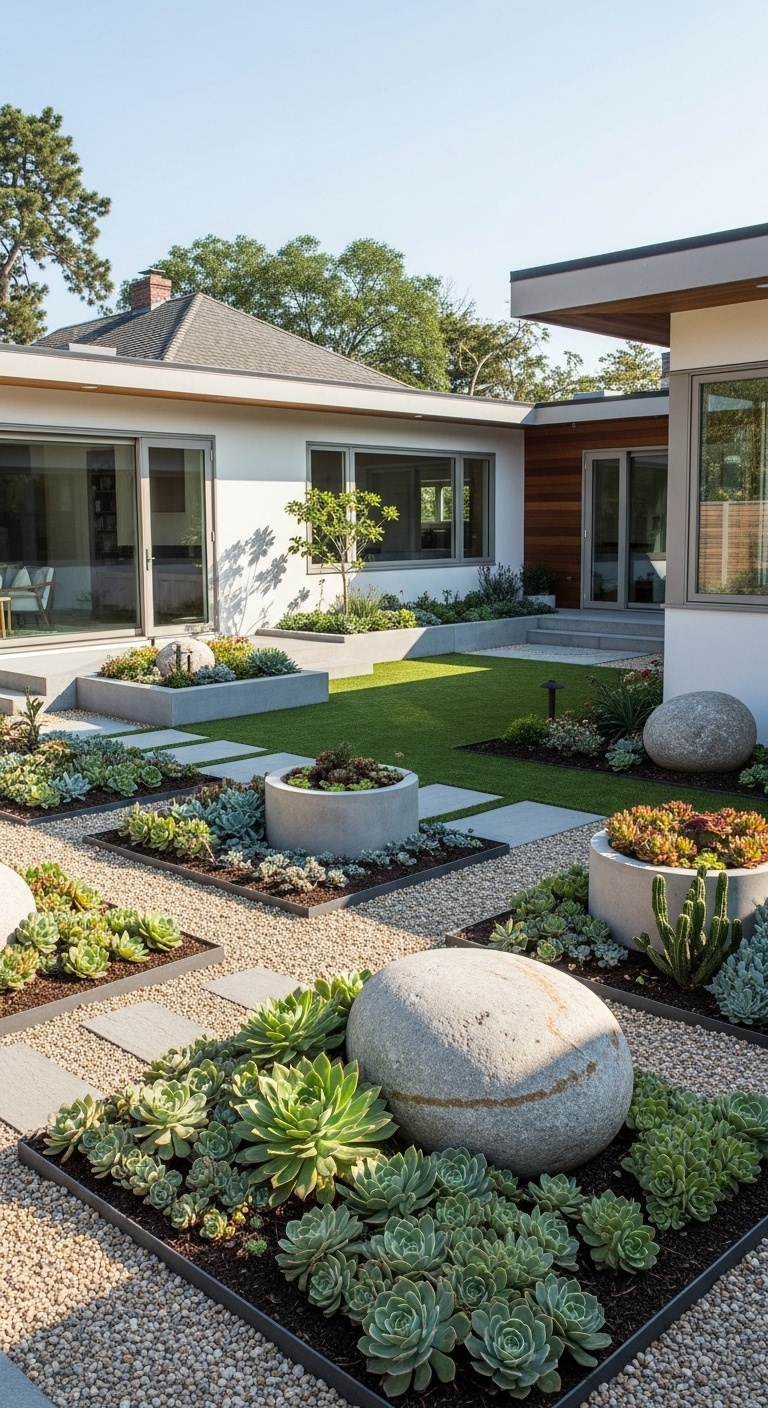
Modern succulents are great for adding a clean and stylish look to your side yard. They come in many shapes and colors, making them easy to fit into any design.
You can mix different succulent species to create interesting patterns.
Use stones or gravel to enhance their appearance and improve drainage.
Consider using containers for a more organized layout. This makes it easy to move them around if you want to change things up.
Keep some taller succulents at the back for contrast, while placing smaller ones in front for depth. This creates a layered look that’s visually appealing.
Remember to choose succulents that can handle your climate. They might require less water than other plants, making them low-maintenance yet beautiful.
Expert Tip from MrPlanter: “Choose a mix of colors and sizes for a modern touch. Regularly check for drainage to keep your plants healthy”.
23. Trellis Plants
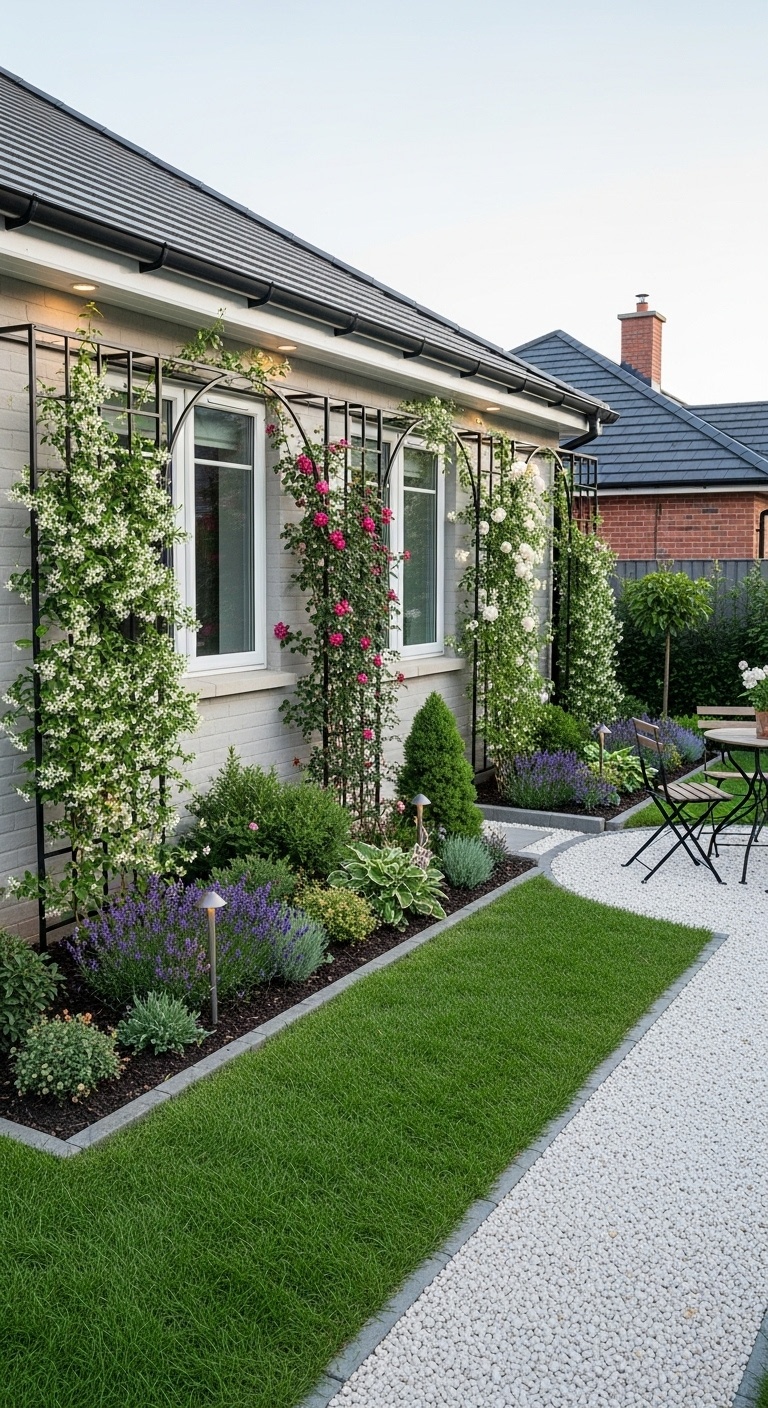
Trellises can add charm and support to the side of your house. They allow climbing plants to grow upward, saving space and creating beauty.
You can use a trellis for various plants, like roses and beans. This makes your garden look vibrant and full of life.
Consider placing a trellis near a fence or wall. It not only fills empty spots but also creates privacy.
For a touch of elegance, choose trellis designs that match your home style. Simple wood, metal, or intricate lattice can complement any setting.
Trellises help keep plants off the ground, which can lead to healthier growth.
Expert Tip from MrPlanter: “Choose plants that thrive in your region for the best results”.
Choosing the Right Plants
Selecting the right plants is key to creating a beautiful side garden. Different plant types can influence the overall look and maintenance level of your space.
Perennials vs. Annuals
Perennials are plants that come back year after year. They can provide a reliable source of color and texture.
Some good choices for side gardens include hostas, daylilies, and sedum. These plants thrive in various light conditions and often require less maintenance once established.
Annuals, on the other hand, last for one growing season. They can add vibrant bursts of color but will need to be replanted each year.
Consider using petunias, marigolds, or zinnias for seasonal highlights. Just remember they need more care and attention.
Most gardeners use a mix of both to create visual interest throughout the seasons. This way, you can enjoy the stability of perennials alongside the bright pops of annuals.
Low-Maintenance Options
If you want a garden that looks great without a lot of effort, go for low-maintenance plants. These options tend to be tougher and can handle varying weather conditions.
Some popular choices include:
- Lavender: This fragrant plant needs little water once established and attracts pollinators.
- Sedum: Known for its thick leaves, sedum is drought-resistant and adds texture.
- Ornamental grasses: They provide movement and usually require minimal care.
By selecting these plants, you can reduce the frequency of watering, pruning, and weeding. This gives you more time to enjoy your outdoor space.
Native Plants
Using native plants is a smart way to support your local ecosystem. These plants are adapted to your region’s climate and soil. They typically require less water and care.
Examples include:
- Coneflowers: They are hardy and attract butterflies.
- Black-eyed Susans: This cheerful flower thrives in sunny spots.
- Yarrow: Known for its medicinal properties, it also flourishes with little attention.
By choosing native plants, you help local wildlife while creating a beautiful landscape. These plants can be the backbone of your side garden, ensuring it thrives with minimal input.
Enhancing Curb Appeal
Enhancing curb appeal can transform the side of your house into a welcoming space. Focusing on design elements like decorative stones, pathways, and art pieces can make a big difference in how your home is perceived.
Using Decorative Stones
Decorative stones can add texture and color to your landscape. Choose stones that complement your home’s exterior. Gravel, river rocks, or flagstone are great options.
You can create borders around garden beds or pathways to define spaces. Use a mix of sizes for visual interest.
Arranging stones in patterns can also enhance the look of your landscaping.
Consider adding a stone pathway. It connects different areas and draws the eye.
This adds a natural feel while guiding guests along their way. Bright, colorful stones can contrast nicely with greenery.
Creating Pathways
Creating pathways along the side of your house is both functional and attractive. Use materials like stepping stones, pavers, or mulch to define a clear route.
Make sure the pathway is wide enough for easy passage.
Arranging stones or pavers in a zig-zag pattern can add appeal.
You might also consider adding lighting along the edges. This will not only look good but help guide visitors at night.
Adding plants alongside the pathway creates a welcoming atmosphere.
Choose low-maintenance flowers or shrubs that thrive in your climate. This makes the path feel more inviting and harmonious with nature.
Incorporating Art Pieces
Adding art pieces can give your landscape personality. Think about sculptures, birdbaths, or decorative pots.
Choose items that reflect your style and the vibe of your home.
Position these art pieces strategically. Place them where they will catch the eye but not obstruct walkways.
You can also create a small seating area with benches and art, making it a perfect spot to relax.
Consider seasonal decorations as well. Items that change with the seasons can keep your landscape dynamic. This adds excitement and can reflect the holidays or changes in nature.
Sustainable Landscaping
Sustainable landscaping focuses on creating and maintaining outdoor spaces that are environmentally friendly. You can use certain techniques to save water and manage waste effectively in your side yard.
Water Conservation Techniques
To save water, consider using drip irrigation systems. These systems deliver water directly to the roots of your plants, minimizing waste and reducing evaporation.
Another method is xeriscaping, which involves using drought-resistant plants.
This not only conserves water but also reduces the need for frequent maintenance.
You can also add rain barrels to collect rainwater from your roof. Use this water for your garden during dry spells.
Lastly, mulch your garden beds. It helps retain moisture, controls weeds, and adds nutrients back to the soil as it breaks down.
Composting Benefits
Composting is a great way to recycle organic waste. You can turn kitchen scraps and yard waste into nutrient-rich fertilizer for your plants.
Start with a compost bin in your side yard. Use materials like vegetable peels, grass clippings, and leaves. Avoid meat and dairy to keep pests away.
As your compost breaks down, you get rich soil that improves plant health. It enhances soil structure and holds moisture better. This reduces your need for extra watering.
Using compost also lowers your carbon footprint by reducing waste sent to landfills. This is a simple way to contribute to the environment while making your landscaping thrive.




